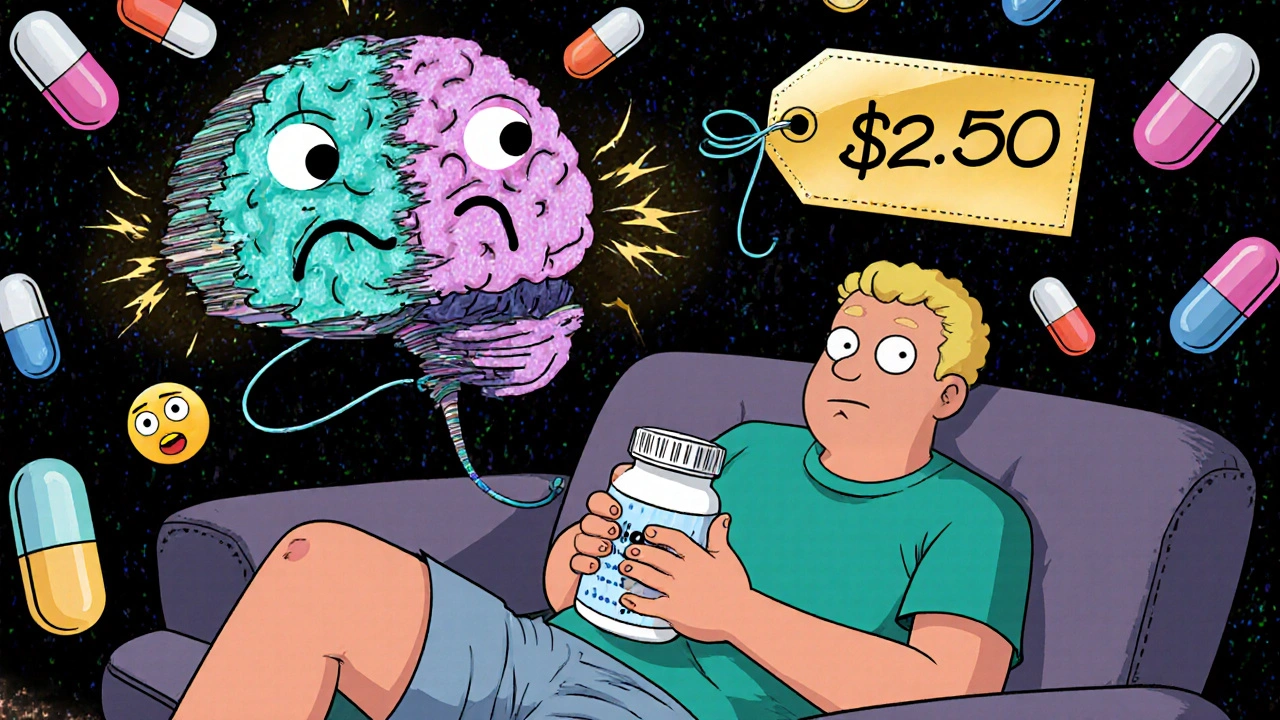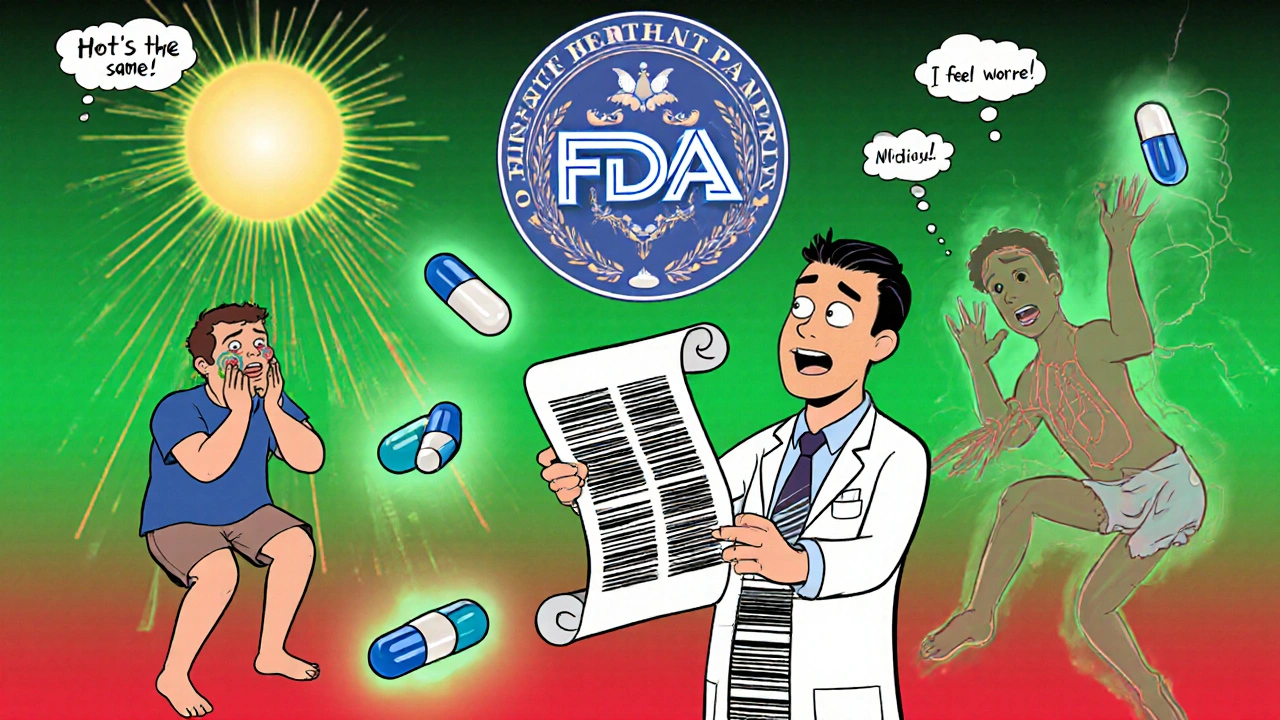When you switch from a brand-name pill to a generic version, your body doesn’t change - but your brain might. You’re getting the same active ingredient, same dosage, same FDA-approved formula. Yet, many people swear the generic doesn’t work as well. Why? It’s not the chemistry. It’s the placebo effect.
Why Your Brain Believes Brand Names Work Better
In 2014, researchers gave people fake painkillers - plain sugar pills - but labeled them as either a well-known brand or a generic. The brand-labeled pills reduced pain nearly as much as real ibuprofen. The generic-labeled ones? Barely any relief at all. Same pill. Same dose. Just different labels. That’s the placebo effect in action: your expectations shape your experience. This isn’t just about headaches. Studies show patients on generic antidepressants report feeling worse - not because the drug changed, but because they believed it would. One trial found 22% more people quit generic sertraline than the brand version, even though both were chemically identical. Their brains expected less, so they got less. fMRI scans back this up. When people think they’re taking a brand-name drug, their dorsolateral prefrontal cortex - the part of the brain tied to expectation and reward - lights up 27% more than when they think they’re taking a generic. That neural activity isn’t imaginary. It triggers real chemical changes in the body that reduce pain, lower blood pressure, or ease anxiety.The Cost-Per-Pill Trap
Here’s another twist: price shapes perception. In one experiment, healthy volunteers received fake painkillers labeled at either $2.50 or $0.10 per pill. The expensive ones worked better - much better. The $2.50 pills reduced pain by 64% more than the cheap ones, even though both were identical placebos. That’s why many people assume generics are weaker. They see the price difference - sometimes 95% lower - and their brain assumes, if it’s this cheap, it can’t be as good. But the FDA requires generics to be bioequivalent: they must deliver the same amount of medicine into your bloodstream within 80-125% of the brand-name version. That’s not a guess. It’s science. Still, the myth sticks. On Drugs.com, nearly 80% of users who switched to generics reported reduced effectiveness. Many wrote about their blood pressure rising, their anxiety returning, or their energy dropping - even when lab tests showed their blood levels were exactly the same as before.The Nocebo Effect: When Expectations Backfire
The flip side of the placebo effect is the nocebo effect: when expecting harm causes real harm. This happens often with generics. In statin trials, people told they were taking a generic version reported muscle pain at rates 3-4 times higher than those told they were taking a brand or didn’t know the label. Some even quit their meds entirely. But when researchers checked their blood, their cholesterol levels were fine. The pain was in their heads - literally. Their brains, primed by marketing or word-of-mouth, started interpreting normal muscle aches as side effects. This isn’t just inconvenient. It’s dangerous. People stop taking life-saving drugs because they think the generic isn’t working. A 2016 study found brand-name users were 18% more likely to stick with their medication over a year than those on generics - even when the pills were identical. That gap? It’s not about efficacy. It’s about trust.
What Doctors Are Doing About It
Some healthcare providers are fighting back - not with more ads, but with better conversations. A 2021 study tested a simple 3-minute script doctors could use when switching patients to generics:- Explain the FDA’s strict bioequivalence rules - how generics must match brand drugs in absorption and effectiveness.
- Admit that some people feel different on generics, but that’s psychological, not chemical.
- Give them a two-week transition window to adjust, and check in after that.
When Generics Really Don’t Work - And When They Do
Let’s be clear: most generics work just fine. For blood pressure, diabetes, cholesterol, and antibiotics, the data is overwhelming. Millions take them every day with zero issues. But some drugs are more sensitive to psychological influence. Antidepressants, painkillers, and thyroid meds (like levothyroxine) show the strongest placebo/nocebo effects. Why? Because their effects are subtle. You don’t feel an immediate “fix.” You notice changes over weeks. That’s when your expectations have time to shape your experience. One patient switched from brand-name levothyroxine to generic and saw her blood pressure jump from 130/80 to 145/92. Her doctor checked her thyroid levels - perfectly normal. She was told her body was adjusting. Two weeks later, her numbers returned to baseline. She didn’t need a different drug. She needed a different mindset. On the flip side, patients who didn’t know they’d switched to generics - because their pharmacy did it quietly - reported just as much benefit as before. Their brains didn’t have time to doubt. The medicine worked.
What You Can Do
If you’re considering switching to a generic - or already did and feel something’s off - here’s what helps:- Ask your doctor to explain how generics are tested. Knowledge reduces fear.
- Don’t assume cheaper means weaker. The FDA doesn’t cut corners.
- Give it two weeks. Your brain needs time to rewire its expectations.
- If you still feel off, talk to your provider - but don’t assume it’s the drug. It might be your belief.
- Ask if your pharmacy keeps the same pill color and shape. Changing appearance can trigger nocebo effects.
The Bigger Picture
The placebo effect isn’t a flaw - it’s a feature of how our bodies work. Medicine isn’t just chemicals. It’s trust. It’s ritual. It’s belief. The $1.4 billion spent every year in the U.S. on unnecessary brand-name prescriptions? That’s not just waste. It’s a failure to understand the mind-body connection. The FDA is now requiring generic manufacturers to keep pill appearance consistent, because even a color change can make people think the drug changed. In Europe, they’re launching a €2.4 million campaign to educate patients on generics. In the U.S., a digital tool called the “Expectation Modulation Protocol” - a 12-minute video that reshapes beliefs about generics - is under FDA review and shows a 53% drop in nocebo responses. This isn’t about tricking people. It’s about helping them get the medicine they need - without the mental baggage.Frequently Asked Questions
Are generic drugs really the same as brand-name drugs?
Yes. The FDA requires generics to have the same active ingredient, strength, dosage form, and route of administration as the brand-name version. They must also meet strict bioequivalence standards - meaning they deliver the same amount of medicine into your bloodstream within a narrow range (80-125%) of the brand. The only differences are inactive ingredients like fillers or dyes, which don’t affect how the drug works.
Why do some people feel worse on generic medications?
It’s often not the drug - it’s the expectation. If you believe a brand-name pill works better, your brain may reduce the placebo effect when you switch to a cheaper generic. This is called the nocebo effect. Studies show people report more side effects and less benefit when they know they’re taking a generic, even when the medicine is identical. Your mind can influence how you feel - even with the same chemical in your body.
Can changing the color or shape of a generic pill affect how well it works?
Yes. Research shows that changing a pill’s appearance - like switching from a blue capsule to a white tablet - can trigger nocebo responses. Patients are more likely to think the medicine changed, even if it didn’t. This leads to higher rates of reported side effects and discontinuation. That’s why the FDA now advises manufacturers to keep generic pills looking as close as possible to the brand version.
Should I avoid generics because of the placebo effect?
No. Generics are safe, effective, and save patients and the healthcare system billions each year. The placebo effect doesn’t mean generics are weaker - it means your brain matters. If you’re concerned, talk to your doctor. Use a simple 3-step approach: learn how generics are tested, give it two weeks to adjust, and monitor how you feel. Most people adapt without issue.
What should I do if I think my generic medication isn’t working?
Don’t stop taking it. First, check your blood levels if possible - many medications (like thyroid or antidepressants) can be tested. If levels are normal, consider whether your expectations might be influencing how you feel. Talk to your provider about the placebo/nocebo effect. Many patients feel better after simply understanding that their brain is adjusting. If you still feel off after two weeks, your doctor can help determine if a switch back is needed - but don’t assume the drug is at fault without evidence.


Comments
Sheldon Bazinga
November 18, 2025 AT 11:02Sandi Moon
November 19, 2025 AT 20:06Kartik Singhal
November 20, 2025 AT 01:20Logan Romine
November 20, 2025 AT 04:19Chris Vere
November 21, 2025 AT 21:46Pravin Manani
November 22, 2025 AT 19:24Mark Kahn
November 23, 2025 AT 08:00Leo Tamisch
November 24, 2025 AT 15:12Daisy L
November 25, 2025 AT 07:25Anne Nylander
November 25, 2025 AT 17:15Franck Emma
November 27, 2025 AT 05:58Noah Fitzsimmons
November 27, 2025 AT 11:54Cooper Long
November 28, 2025 AT 10:37Pawan Jamwal
November 30, 2025 AT 00:22